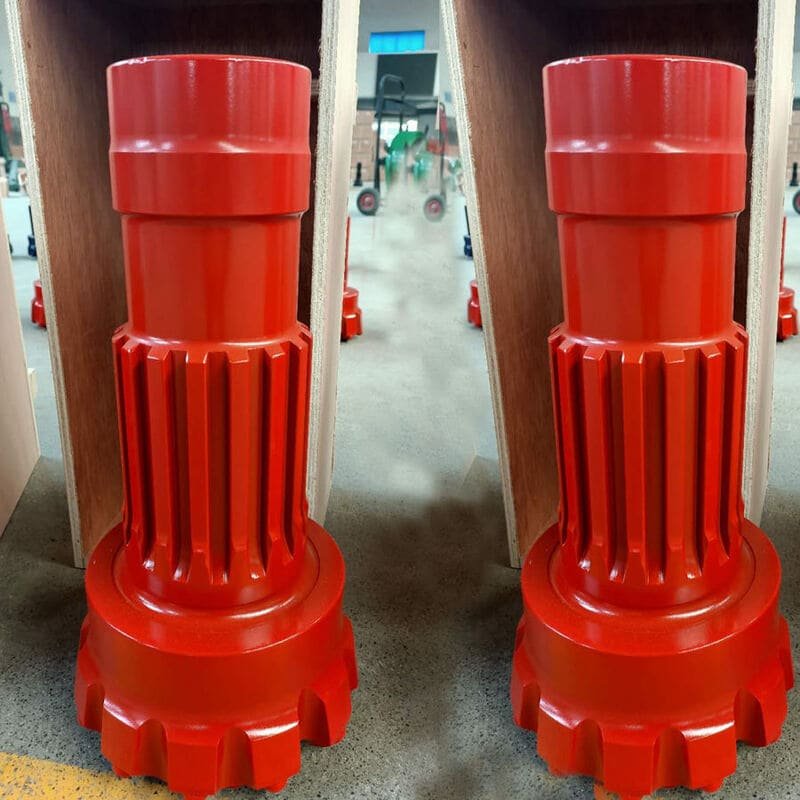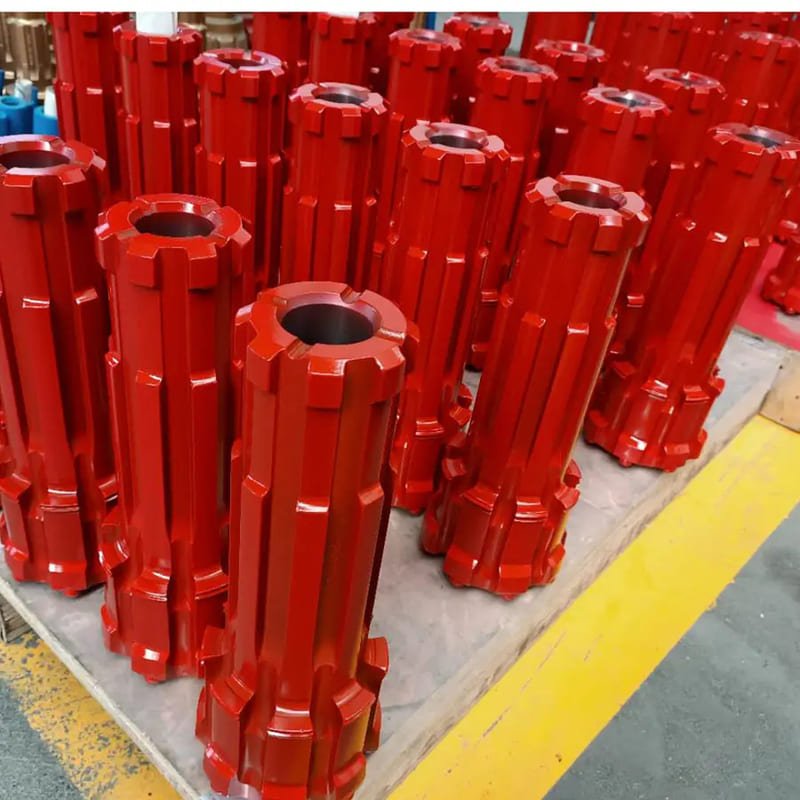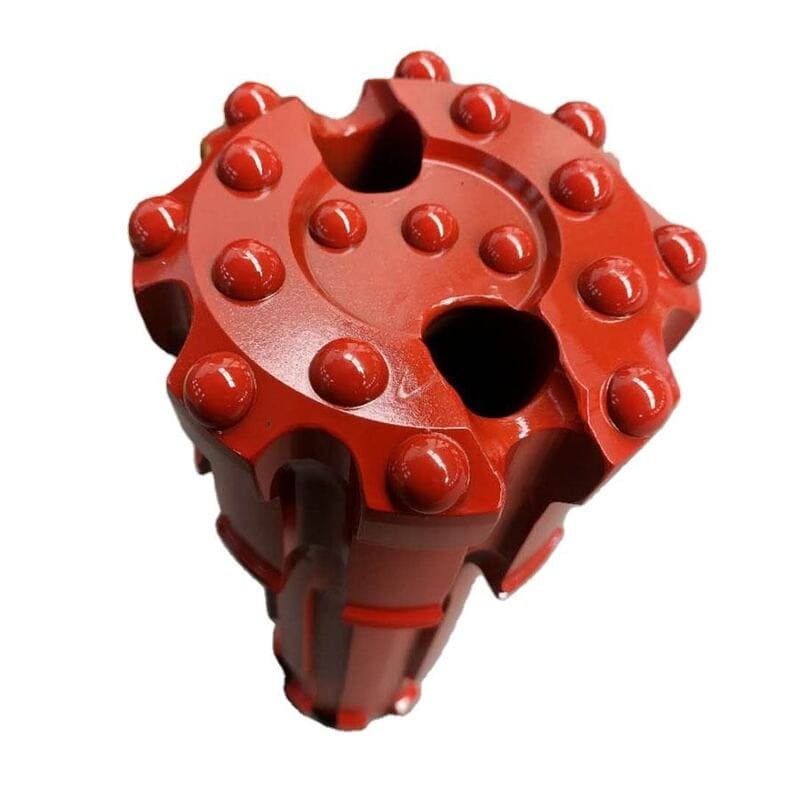Ever felt like you're drilling blind? Knowing the right drill bit length can illuminate your path to success.
Standard DTH drill bit lengths range from 350 mm to over 1 meter, tailored to hammer size, hole diameter, and depth. Choosing the right length boosts drilling efficiency and precision.
I remember my first big drilling project, standing there like a deer in headlights, trying to figure out which bit length to use. It seemed daunting, but once I understood how hammer size, hole diameter, and depth of application play into choosing the right length, it all clicked. Larger hammers need longer bits to make sure every strike counts. And if you're aiming for wider or deeper holes, you'll want longer bits to maintain stability and precision. It's like picking the right golf club for a tricky shot—choosing well can make all the difference. So, take these factors into account, and you'll drill with confidence and efficiency.
Standard DTH drill bit lengths start at 200 mm.False
Standard lengths typically start at 350 mm, not 200 mm.
DTH drill bit length affects drilling efficiency.True
Choosing the correct length ensures efficient and accurate drilling.
How Does Hammer Size Affect Drill Bit Length?
Ever wondered why your drilling projects don't always go as planned? It might be the hammer size!
Hammer size affects drill bit length by requiring longer bits for larger hammers, ensuring optimal drilling performance and stability, crucial for deep or wide-diameter holes.

Hammer Size and Its Influence on Drill Bits
I remember the first time I realized how much hammer size could influence my drilling work. I was trying to get a project done with a smaller hammer and kept wondering why things weren't lining up right. Turns out, the size of the hammer can make a world of difference. Larger hammers typically demand longer bits to maintain stability and ensure efficient power transfer during drilling operations. This is particularly significant in applications requiring deeper penetration or wider hole diameters.
| Hammer Size | Typical Bit Length |
|---|---|
| Small | 350mm - 600mm |
| Medium | 500mm - 800mm |
| Large | 700mm - Over 1 meter |
This table gives you a sense of what bit lengths to aim for with different hammer sizes. While these ranges provide a general guideline, I've learned that it's crucial to consider specific project requirements and geological conditions1 that may necessitate custom lengths.
Factors Influencing Drill Bit Length
Hole Diameter
I’ve noticed that the desired hole diameter plays a critical role in selecting the appropriate drill bit length. Larger diameter holes often require longer bits to maintain hole straightness and stability during drilling. This relationship between diameter and length ensures that the drilling process remains consistent and accurate.
Application Depth
The deeper the application, the more challenging it gets. In my experience, especially in mining or construction projects where deep boreholes are needed, longer bits are essential. They ensure that the drilling process remains efficient and produces high-quality results.
Stability and Performance
When it comes to stability and performance, using a drill bit length that matches the hammer size is key. It minimizes vibrations and ensures that the energy from the hammer is effectively transferred to the bit, improving penetration rates and reducing wear on both the hammer and bit.
Considering these factors, choosing a drill bit that aligns with both the hammer size and the specific requirements of your project is essential. For those in industrial applications like myself, investing in high-quality, compatible equipment can lead to improved operational efficiency and reduced maintenance costs.
Understanding these dynamics has helped me make more informed decisions about tool selection2, ultimately leading to more effective drilling outcomes.
Larger hammers need longer drill bits for stability.True
Larger hammers require longer bits to maintain stability and ensure efficient power transfer.
Small hammers can use drill bits over 1 meter long.False
Small hammers typically use drill bits between 350mm and 600mm, not over 1 meter.
Why is the hole diameter crucial when choosing drill bit length?
Have you ever started a project only to realize your drill bit isn't the right length for the hole diameter?
Choosing the right drill bit length for your hole diameter is essential because it ensures precision, stability, and optimal drilling performance. Larger hole diameters usually require longer drill bits to maintain alignment and reduce the risk of tool deflection during drilling.

The Role of Hole Diameter in Drilling
I remember the first time I tackled a big DIY project. I was so focused on getting the right materials that I overlooked one crucial detail: the drill bit length relative to the hole diameter. That small oversight taught me a big lesson about drilling efficiency.
| Hole Diameter | Recommended Bit Length |
|---|---|
| Small (≤ 76mm) | 350mm to 600mm |
| Medium (77mm-152mm) | 500mm to 800mm |
| Large (≥ 153mm) | 700mm to over 1 meter |
This table helps ensure I never forget how different hole diameters require specific bit lengths for efficiency and minimal tool wear.
Stability and Accuracy
I've realized that maintaining stability during drilling is like trying to walk a straight line while balancing a book on your head. You need precision and focus. Longer drill bits are my go-to for larger holes because they keep everything aligned, which is vital, especially in challenging geological conditions3 where deflection risks are high.
Application Specifics
Different projects call for different drill bit lengths. For construction projects4 I've worked on, longer bits were necessary to maintain the structural integrity of the material. Meanwhile, smaller tasks were all about precision and reducing waste with shorter bits.
Material Considerations
The material you're drilling into matters too. Harder materials can wear out tools quickly if you don't choose the right bit length. From my experience, using longer bits can exert enough force without causing damage or excessive wear. Moreover, selecting the correct material type5 for your drill bits can enhance performance and lifespan.
Understanding these factors has really transformed how I approach drilling tasks, ensuring each project is completed with efficiency and precision.
Larger hole diameters require longer drill bits.True
Larger holes need longer bits for stability and alignment.
Shorter drill bits are ideal for large diameter holes.False
Shorter bits lack the length needed to stabilize large holes.
How Does Application Depth Affect Drill Bit Length Choice?
Ever stared at a stack of drill bits and wondered which one's right for the job? I've been there, believe me. Let's dive into why application depth is your best buddy in making that choice.
The depth you're drilling into plays a huge role in picking the right drill bit length. For deeper holes, you'll need longer bits to keep things stable and hit the right depth. Remember to factor in hole size and the ground you're working with.

Influence of Application Depth on Drill Bit Length
I remember the first time I tackled a major drilling project; it was like staring into an abyss of choices! Choosing the right drill bit felt overwhelming, but understanding depth changed everything. Simply put, the deeper you go, the longer the bit you need. It’s all about stability and hitting your target depth without veering off course. Let me break it down for you:
| Depth Range | Recommended Bit Length |
|---|---|
| Shallow (<20m) | 300-500 mm |
| Medium (20-50m) | 500-800 mm |
| Deep (>50m) | 800 mm and above |
Importance of Drill Bit Length in Stability
Picture this: you're drilling deep into the earth, and your bit suddenly wobbles—frustrating, right? Longer drill bits offer that much-needed stability to maintain a straight path, especially when you're digging deep. With the wrong length, accuracy goes out the window. It took me a while to learn that considering application depth helps select the right bit dimensions6 for precise operations.
Consideration of Geological Conditions
Then there’s the ground itself—sometimes it's like nature throws a curveball! Hard or abrasive rocks demand more robust, often longer bits to withstand wear and tear while keeping up effective penetration rates. Evaluating these factors ensures that the bit length aligns with your project's geological challenges7.
Balancing Bit Diameter and Length
I've also learned the importance of balancing bit diameter with length. It’s kind of like pairing the right wine with dinner—get it wrong, and you’ll notice. A wider diameter often needs a longer bit to keep things solid during drilling. This balance optimizes performance without sacrificing efficiency8. Proper selection can significantly reduce downtime due to tool failure.
Understanding these elements helps me make informed decisions about drill bit selection, ensuring both project success and equipment longevity. It's all about maximizing efficiency and drilling outcomes.
Deeper applications require longer drill bits.True
Longer bits provide stability and accuracy in deeper drilling tasks.
Shallow applications need drill bits over 800 mm long.False
Shallow applications typically use 300-500 mm long drill bits.
Can I Get Custom Length Drill Bits for My Specific Drilling Needs?
Have you ever faced a drilling challenge that seemed impossible with standard tools?
Yes, you can get custom length drill bits to meet your specific drilling needs. Manufacturers offer these tailored solutions by adjusting bit lengths, which can enhance performance based on factors like hammer size, hole diameter, and depth of application.

Understanding the Need for Custom Length Drill Bits
Imagine standing at a project site, staring at a patch of stubborn rock that refuses to budge with the usual gear. I’ve been there, wondering if there's a secret weapon to make my work more efficient. That's where custom length drill bits come into play.
Standard equipment often feels like trying to fit a square peg in a round hole—it's not one-size-fits-all. Sometimes, your projects demand something more specific. For instance, drilling through particularly dense rock might need a bit longer than usual to keep everything stable and straight.
| Factor | Impact on Bit Length |
|---|---|
| Hammer Size | Larger hammers necessitate longer bits for effective use. |
| Hole Diameter | Wider holes may require longer bits for precise drilling. |
| Application Depth | Deeper applications demand longer bits for enhanced reach. |
Custom Solutions from Manufacturers
It's comforting to know that many manufacturers are ready to step in with custom solutions. They'll adjust the length to precisely what you need, so you don't have to compromise on your project's success.
- Adjustments in Length: Customization can mean extending or shortening the bit, perfectly tailored for what you're up against.
- Material Considerations: Sometimes the environment is so unique that the bit itself needs special materials to withstand the conditions.
Manufacturers often have engineers who can recommend the best length for your drill bit based on your needs, ensuring everything is aligned with your goals.
Finding the Right Manufacturer
Choosing the right partner is crucial when it comes to custom length drill bits. You want someone who offers more than just the product; comprehensive technical support is key.
- Technical Support: Ensure the manufacturer provides comprehensive technical support9 throughout the project lifecycle.
- Quality Assurance: Check for certifications10 that guarantee compliance with international quality standards.
These partnerships can make all the difference, ensuring every piece of equipment is precisely what you need for efficiency and success in your drilling endeavors.
Custom length drill bits are essential for unique projects.True
Custom bits ensure precision and efficiency in challenging drilling scenarios.
Standard drill bits fit all geological conditions.False
Standard bits often fail in unique conditions, necessitating custom lengths.
Conclusion
Standard DTH drill bit lengths range from 350 mm to over 1 meter, influenced by hammer size, hole diameter, and application depth for optimal drilling efficiency.
-
Learn about geological conditions that influence drill bit selection, ensuring you choose the right tools for your specific drilling environment. ↩
-
Explore guidelines on selecting tools that ensure optimal drilling performance, crucial for efficiency in various applications. ↩
-
Explore how geological conditions influence drill bit choice to ensure stable and accurate drilling. ↩
-
Learn about the specific drill bit lengths needed for various construction applications. ↩
-
Discover which materials are best suited for drill bits when working with hard surfaces. ↩
-
Explores how longer bits improve stability and drilling accuracy, vital for deep applications. ↩
-
Analyzes the impact of geological factors on bit length selection, ensuring optimal performance. ↩
-
Discusses balancing dimensions to enhance efficiency and reduce tool failure. ↩
-
This link offers insights into the technical support services that accompany custom drill bit solutions, ensuring effective project execution. ↩
-
Exploring this link will provide details on certifications that affirm the quality and reliability of custom drill bits. ↩








